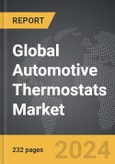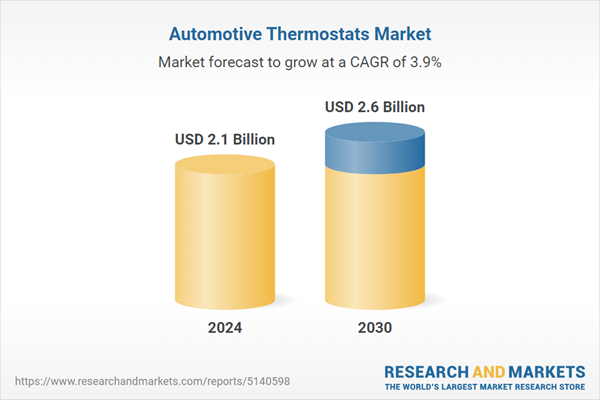Global Automotive Thermostats Market - Key Trends and Drivers Summarized
Why Are Automotive Thermostats the Hidden Guardians of Engine Efficiency?
Automotive thermostats, though often overlooked, are vital components in the management of engine temperature, ensuring that vehicles operate within the optimal range. These devices regulate the flow of coolant between the engine and the radiator, preventing overheating by allowing the engine to reach and maintain its ideal operating temperature. Without a properly functioning thermostat, engines would either overheat, causing potential damage, or run too cool, reducing efficiency and increasing emissions. Modern engines, particularly those in high-performance and turbocharged vehicles, demand precise temperature control to achieve maximum efficiency. The role of thermostats becomes even more critical in extreme weather conditions, where maintaining a stable engine temperature can be challenging. Advances in thermostat technology, such as the development of electronically controlled thermostats, have improved the accuracy and responsiveness of these components, allowing for better fuel efficiency and reduced emissions.How Are Innovations in Thermostat Design Keeping Up with Modern Engine Demands?
The evolution of automotive engines has necessitated significant advancements in thermostat design and functionality. Traditional wax thermostats, which rely on the expansion and contraction of wax to control temperature, are gradually being replaced by electronically controlled thermostats that offer superior precision and faster response times. These modern thermostats can adjust the engine's temperature more dynamically, responding to changes in driving conditions, load, and external temperatures. This is particularly important in newer engines that operate at higher temperatures to improve efficiency and reduce emissions. Additionally, the shift towards lightweight materials in automotive manufacturing has influenced thermostat design, leading to the use of advanced composites and alloys that can withstand higher temperatures and pressures. These innovations ensure that thermostats continue to perform reliably in the increasingly demanding environments of modern engines.What Is Driving the Demand for Advanced Automotive Thermostats in Electric and Hybrid Vehicles?
The rise of electric and hybrid vehicles has introduced new challenges and opportunities for automotive thermostat technology. Unlike traditional internal combustion engines, electric vehicles (EVs) and hybrids rely on battery packs and electric motors, which also require effective thermal management to maintain performance and longevity. In these vehicles, thermostats play a crucial role in managing the temperature of the battery packs, ensuring that they remain within a safe operating range. This is critical not only for the efficiency of the vehicle but also for safety, as overheating batteries can lead to dangerous situations. As a result, there has been a growing demand for specialized thermostats designed specifically for use in electric and hybrid vehicles. These thermostats are often integrated into more complex thermal management systems that include sensors, pumps, and electronic controls, reflecting the increased complexity of modern automotive cooling systems.What Factors Are Driving Growth in the Automotive Thermostats Market?
The growth in the automotive thermostats market is driven by several factors that are closely tied to technological advancements and shifts in the automotive industry. The increasing adoption of electric and hybrid vehicles is a major driver, as these vehicles require more sophisticated thermal management solutions, including advanced thermostats. Additionally, the trend towards higher engine efficiency and reduced emissions in traditional vehicles has spurred the development of more precise and responsive thermostats, further boosting market demand. The use of lightweight materials in automotive manufacturing, which necessitates thermostats that can operate under higher temperatures and pressures, is also contributing to market growth. Furthermore, stringent global regulations on vehicle emissions and fuel efficiency are pushing manufacturers to adopt advanced thermostat technologies that can help engines run more efficiently. Lastly, the growing consumer demand for reliable and long-lasting vehicles is encouraging automakers to invest in high-quality thermostats that enhance engine performance and durability, driving further expansion in this market.Report Scope
The report analyzes the Automotive Thermostats market, presented in terms of market value (USD). The analysis covers the key segments and geographic regions outlined below.- Segments: Distribution Channel (OEM, Aftermarket); End-Use (Passenger Cars, Commercial Vehicles).
- Geographic Regions/Countries: World; United States; Canada; Japan; China; Europe (France; Germany; Italy; United Kingdom; Spain; Russia; and Rest of Europe); Asia-Pacific (Australia; India; South Korea; and Rest of Asia-Pacific); Latin America (Argentina; Brazil; Mexico; and Rest of Latin America); Middle East (Iran; Israel; Saudi Arabia; United Arab Emirates; and Rest of Middle East); and Africa.
Key Insights:
- Market Growth: Understand the significant growth trajectory of the OEM Distribution Channel segment, which is expected to reach US$1.5 Billion by 2030 with a CAGR of 4.1%. The Aftermarket Distribution Channel segment is also set to grow at 3.5% CAGR over the analysis period.
- Regional Analysis: Gain insights into the U.S. market, valued at $549.6 Million in 2024, and China, forecasted to grow at an impressive 5.9% CAGR to reach $546 Million by 2030. Discover growth trends in other key regions, including Japan, Canada, Germany, and the Asia-Pacific.
Why You Should Buy This Report:
- Detailed Market Analysis: Access a thorough analysis of the Global Automotive Thermostats Market, covering all major geographic regions and market segments.
- Competitive Insights: Get an overview of the competitive landscape, including the market presence of major players across different geographies.
- Future Trends and Drivers: Understand the key trends and drivers shaping the future of the Global Automotive Thermostats Market.
- Actionable Insights: Benefit from actionable insights that can help you identify new revenue opportunities and make strategic business decisions.
Key Questions Answered:
- How is the Global Automotive Thermostats Market expected to evolve by 2030?
- What are the main drivers and restraints affecting the market?
- Which market segments will grow the most over the forecast period?
- How will market shares for different regions and segments change by 2030?
- Who are the leading players in the market, and what are their prospects?
Report Features:
- Comprehensive Market Data: Independent analysis of annual sales and market forecasts in US$ Million from 2024 to 2030.
- In-Depth Regional Analysis: Detailed insights into key markets, including the U.S., China, Japan, Canada, Europe, Asia-Pacific, Latin America, Middle East, and Africa.
- Company Profiles: Coverage of players such as Adel Group (Asia) Ltd., Alex Original Limited, American Standard Heating and Air Conditioning, Ascon Tecnologic Srl, ATEK SENSOR TECHNOLOGIE and more.
- Complimentary Updates: Receive free report updates for one year to keep you informed of the latest market developments.
Some of the 13 companies featured in this Automotive Thermostats market report include:
- Adel Group (Asia) Ltd.
- Alex Original Limited
- American Standard Heating and Air Conditioning
- Ascon Tecnologic Srl
- ATEK SENSOR TECHNOLOGIE
- Backer BHV AB
- BBB Industries LLC
- BorgWarner, Inc.
- Bowman's Plumbing & Heating Inc.
- Braeburn Systems LLC
This edition integrates the latest global trade and economic shifts into comprehensive market analysis. Key updates include:
- Tariff and Trade Impact: Insights into global tariff negotiations across 180+ countries, with analysis of supply chain turbulence, sourcing disruptions, and geographic realignment. Special focus on 2025 as a pivotal year for trade tensions, including updated perspectives on the Trump-era tariffs.
- Adjusted Forecasts and Analytics: Revised global and regional market forecasts through 2030, incorporating tariff effects, economic uncertainty, and structural changes in globalization. Includes historical analysis from 2015 to 2023.
- Strategic Market Dynamics: Evaluation of revised market prospects, regional outlooks, and key economic indicators such as population and urbanization trends.
- Innovation & Technology Trends: Latest developments in product and process innovation, emerging technologies, and key industry drivers shaping the competitive landscape.
- Competitive Intelligence: Updated global market share estimates for 2025, competitive positioning of major players (Strong/Active/Niche/Trivial), and refined focus on leading global brands and core players.
- Expert Insight & Commentary: Strategic analysis from economists, trade experts, and domain specialists to contextualize market shifts and identify emerging opportunities.
Table of Contents
Companies Mentioned (Partial List)
A selection of companies mentioned in this report includes, but is not limited to:
- Adel Group (Asia) Ltd.
- Alex Original Limited
- American Standard Heating and Air Conditioning
- Ascon Tecnologic Srl
- ATEK SENSOR TECHNOLOGIE
- Backer BHV AB
- BBB Industries LLC
- BorgWarner, Inc.
- Bowman's Plumbing & Heating Inc.
- Braeburn Systems LLC
Table Information
| Report Attribute | Details |
|---|---|
| No. of Pages | 232 |
| Published | October 2025 |
| Forecast Period | 2024 - 2030 |
| Estimated Market Value ( USD | $ 2.1 Billion |
| Forecasted Market Value ( USD | $ 2.6 Billion |
| Compound Annual Growth Rate | 3.9% |
| Regions Covered | Global |









